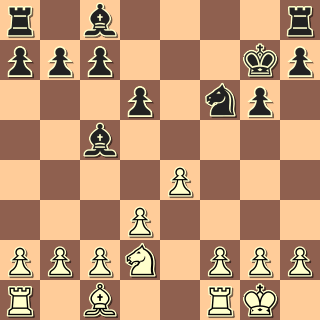In the following game Philidor1792 takes on a higher-rated player, side-steps some historical pitfalls, and shows that an advanced "Jerome pawn" is the match for Black's extra piece.
Philidor1792 - Dayana2006
Russia Central Federal District vs Flyi, Chess.com, 2015
1.e4 e5 2.Nf3 Nc6 3.Bc4 Bc5 4.Bxf7+
4...Kxf7 5.Nxe5+ Nxe5 6.Qh5+ Kf8
This defense is as old as Alonzo Wheeler Jerome's analysis in the March 1875 issue of the Dubuque Chess Journal, and appeared in a game as early as Jaeger - Jerome, correspondence, 1880, (0-1, 40).
7.Qxe5 d6 8.Qg3 Nf6 9.d3 Nh5 10.Qf3+ Qf6 11.Nd2
Practice shows the error of 11.Qxh5?: chessmanjeff - Gardenz, FICS, 2012 (0-1, 18) and ZahariSokolov - Jiracek, FICS, 2014 (0-1, 45).
Also not recommended is 11.Be3?! Qxf3 12.gxf3 as in obviously - belgje, GameKnot.com, 2004 (0-1, 19).
White has done better with 11.Qxf6+, e.g. destinyx - belgje, GameKnot.com, 2004 (1-0, 80) and raes - belgje, GameKnot.com, 2004 (0-1, 49).
11...g6
Black should not temporize with 11...Be6?, as then the capture of the Knight 12.Qxh5 is playable, i.e. 12...Qxf2+ 13.Kd1 Qxg2 14.Qf3+ Qxf3+ 15.Nxf3 as in lamacuk - tomwhufc, GameKnot.com, 2007 (1-0, 29).
12.0-0 Kg7 13.Qxf6+ Nxf6
Philidor1792 has been comfortable taking the two extra pawns vs Black's extra piece in blitz games, where strategy is sometimes no deeper than "push the 'Jerome pawns' ". Here he works just as effectively at a slower time limit.
14.c3 Bg4 15.d4 Bb6 16.f3 Bd7 17.Nc4 h6 18.Re1 Rhe8 19.Kf2 d5 20.Nxb6 axb6 21.e5 Nh7
22.Be3 Nf8 23.g4 Ne6 24.Kg3 g5 25.h4 Rf8 26.Rh1 Bb5 27.Rh2 Rf7 28.Rah1 Raf8
29.Rf2 Bd3 30.hxg5 Nxg5 31.Bxg5 hxg5 32.Re1 Re8 33.Rh2 Bg6 34.a3 Rf4 35.e6 Re7
36.Re5 Kf6 37.Rhe2 c6 38.a4 Re8 39.Re1 Rh8 40.e7 Re8 41.b4 Bc2 42.a5 bxa5 43.bxa5 Bd3 44.Rd1 Bc2 45.Rc1 Ba4 46.Rce1 Bb5 47.Re6+ Kf7 48.R6e5 Kf6 Drawn
In light of the coming repetition of position, the players agreed to split the point.
.png)
.png)

.png)
.png)
.png)
.png)
.png)
.png)

.png)
.png)
.png)
.png)
.png)
.png)
.png)
.png)

.png)
.png)
.png)

.png)
.png)
.png)
.png)
.png)

.png)
.png)
.png)
.png)
.png)